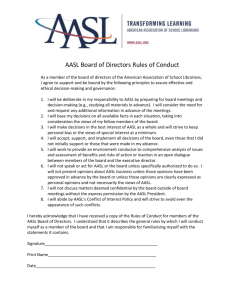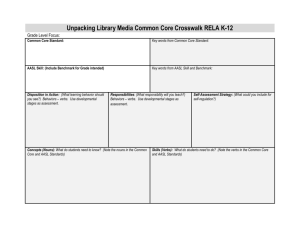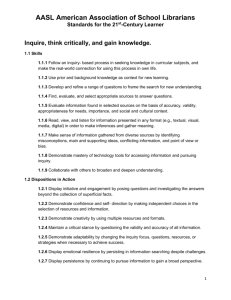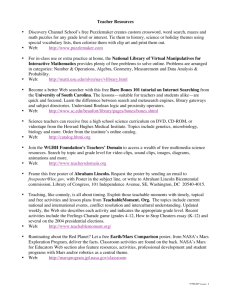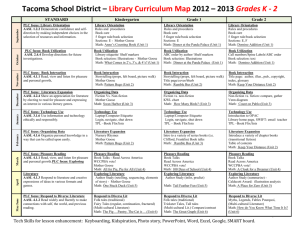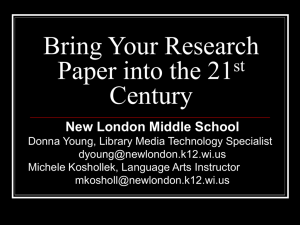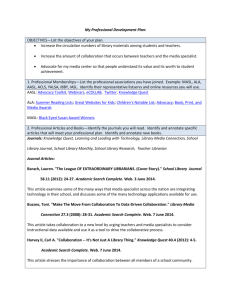AASL Standards
advertisement
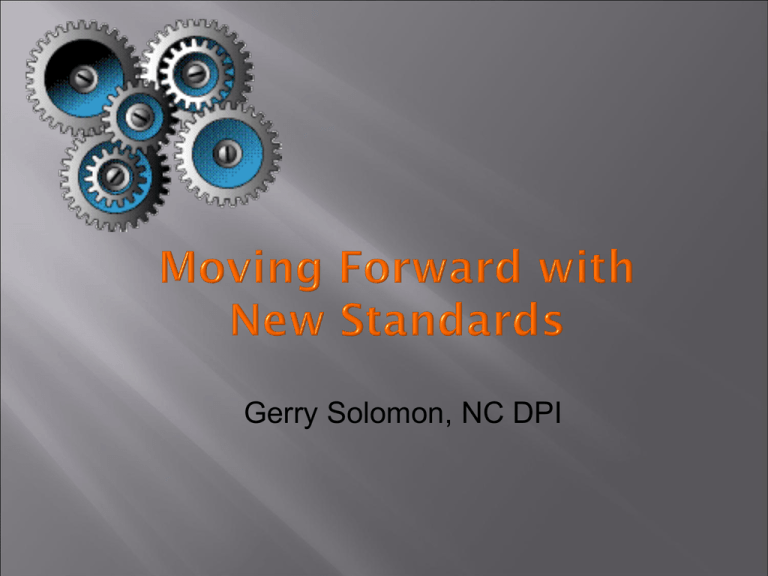
Gerry Solomon, NC DPI Information Power, 1986, 1998. “Your practices must truly mirror what you believe.” Everett Kline, Educational Consultant AASL Fall Forum 2008 Learning 4 Life (L4L): National Plan for Implementation of Standards for the 21st-Century Learner and Guidelines for the School Library Media Program http://ala.org/ala/mgrps/divs/aasl/aaslproftools/learning4life/index.cfm Reading is a window to the world. Inquiry provides a framework for learning. Ethical behavior in the use of information must be taught. Technology skills are crucial for future employment needs. Equitable access is a key component for education. Gail Dickinson, Ph.D., Old Dominion University The definition of information literacy has become more complex as resources and technologies have changed. The continuing expansion of information demands that all individuals acquire the thinking skills to learn on their own. Learning has a social context. School libraries are essential to the development of learning skills. Gail Dickinson, Ph.D., Old Dominion University Framework for 21st Century Learning Inquire, think critically, and gain knowledge Draw conclusions, make informed decisions, apply knowledge…. Share knowledge and participate ethically and productively… Pursue personal and aesthetic growth http://www.ala.org/ala/aasl/aaslproftools/learningstandards /standards.cfm Key abilities needed for understanding, learning, thinking, and mastering subjects. Key Question: does the student have the right proficiencies to explore a topic or subject further? Gail Dickinson, Ph.D Old Dominion University Ongoing beliefs and attitudes that guide thinking and intellectual behavior that can be measured through actions taken. Key Question: Is the student disposed to higher level thinking and actively engaged in critical thinking to gain and share knowledge? Gail Dickinson, Ph.D Old Dominion University Common behaviors used by independent learners in researching, investigating, and problem solving. Key Question: Is the student aware that the foundational traits for 21st century learning require self-accountability that extends beyond skills and dispositions? Gail Dickinson, Ph.D Old Dominion University Reflections on one’s own learning to determine that the skills, dispositions, and responsibilities are effective. Key Question: Is the student able to recognize personal strengths and weaknesses over time to become a stronger, more independent learner? Gail Dickinson, Ph.D Old Dominion University SKILLS (key abilities) Read, Find, Evaluate DISPOSTIONS IN ACTION Demonstrate, Display RESPONSIBILITIES Contribute, Respect, Behave Ethically (behaviors of independent learners) SELF-ASSESSMENT STRATEGIES Reflect on learning Skills Dispositions Responsibilities Self-Assessments Assessing Skills Assessing Dispositions Assessing Responsibilities Assessing Self-Assessments Gail Dickinson, Ph.D Old Dominion University What we teach helps to close the learning gap. If we are teaching partners, we are also partners in assessment. Violet H. Harada University of Hawaii AASL Fall Forum 2006 The measurement of knowledge and skills during the process of learning in order to inform the next steps Barbara Stripling AASL Fall Forum, 2006 Teacher-Led: Ungraded Exams and Drafts Checklists and Rubrics Exit Cards and Journal Responses Observation Checklist Consultation Barbara Stripling AASL Fall Forum 2006 Learner-Led: Reflecting (Learning Logs, Notetaking) Questioning Organizing Sharing (Reciprocal Teaching) Challenging (Challenging Questions) Evaluating Barbara Stripling AASL Fall Forum 2006 The measurement of knowledge and skills at the end of a process of learning in order to determine the amount and quality of learning Barbara Stripling AASL Fall Forum 2006 Teacher-Led: Authentic Product Presentation or Exhibition Performance Task Portfolio / Process Folio Checklist Rubrics Barbara Stripling AASL Fall Forum 2006 Learner-Led: Concept Map Final Reflection Authentic Product Presentation or Exhibition Portfolio / Process Folio Checklist Rubric Barbara Stripling AASL Fall Forum 2006 Overview: As part of a science unit on conservation, sixth grade students will research alternative energy sources and communicate their knowledge by participating in a panel discussion on mock alternative energy solutions. An essential question framing their inquiry is: Which alternative energy sources will sustain a healthier and cleaner environment? AASL Standards for the 21st-Century Learner in Action, Draft 2 Students compose prepared remarks and deliver oral presentations for panel discussions. All work must be properly cited. AASL Standards for the 21st-Century Learner in Action, Draft 2 Teachers and the SLMS gauge student performance by using a rubric to assess students’ progress in: generating and answering questions determining accuracy, credibility, and relevance of information gathering information from appropriate sources taking notes in own words synthesizing notes for the presentation. AASL Standards for the 21st-Century Learner in Action, Draft 2 Teachers, the SLMS, and students use an instructor-designed rubric to assess the panel presentation on the basis of: content accuracy organization of ideas and details communication skills AASL Standards for the 21st-Century Learner in Action, Draft 2 Benchmarks Grades 2, 5, 8, 10, 12 Action Examples and Scenarios Cause students to understand: Insight into key ideas, as reflected in wise inferences regarding the knowledge and skill to be learned (making meaning) Effective use of knowledge and skill in varied, important, realistic, and novel situations. (enabling transfer) Used with permission of Everett Kline AASL Fall Forum 2008 With your group, develop a dress code for your school and present it as a music video. Before you begin, complete a project plan which includes the goal of the project, research strategies, and resources needed. Assign responsibilities and tasks to each member of the group. Meet regularly to monitor progress on individual tasks and then to come to consensus on what should be included in the final production. Present video as part of an inclass video festival. Standards in Action, Draft One, AASL Disposition 3.2.1: Demonstrate leadership and confidence by presenting ideas… Responsibility 2.3.1: Connect understanding to the real world. “Inquire, think critically, and gain knowledge.” Standards for the 21st Century Learner, AASL 2007. Grade 2 Indicator: Form simple questions and begin to explore ways to answer them. Benchmarks: Formulate questions related to listening activities Ask “I wonder” questions about the topic, question, or problem Standards for the 21st Century Learner in Action, AASL 2009 “Second graders will learn about famous African American historical figures…The teachers and the SLMS work together to create a graphic organizer…Research questions will be developed through a guided brainstorming activity…” Standards for the 21st Century Learner in Action AASL, 2009 “If we keep assigning topics, students will drive their earth moving equipment through the information landfill, pleased by the height and depth of the piles.” McKenzie, Jamie. "Putting an End to Topical Research." From Now On. Vol 16 No 3. February 2007. Look for connections between information Trigger forming an opinion about the information found Use comparisons and looking for patterns Require THOUGHTFUL answers IN 2 EDU: Information Literacy http://www.in2edu.com/downloads/infolit/index. htm “Draw conclusions, make informed decisions, apply knowledge to new situations, and create new knowledge.” Standards for the 21st Century Learner, AASL 2007. Assess the importance of ideas by comparing… Identify main ideas and supporting examples… Analyze different points of view… Determine patterns and discrepancies by comparing… Interpret information and ideas by defining, classifying… Standards for the 21st Century Learner in Action, AASL 2009 “Share knowledge and participate ethically and productively as members of our democratic society.” Standards for the 21st Century Learner, AASL 2007. “Pursue personal and aesthetic growth.” Standards for the 21st Century Learner, AASL 2007. “The guiding mission of the North Carolina State Board of Education is that every public school student will graduate from high school, globally competitive for work and postsecondary education and prepared for life in the 21st century.” http://www.ncpublicschools.org/sbe_meetings/rev isions/2006/pdfs/0609/sbefgfrs2.pdf NCDPI Communications and Information Division 2007 Basic operations and concepts Social, ethical, and human issues Technology productivity tools Technology communications tools Technology research tools Technology problem-solving and decisionmaking tools http://cnets.iste.org/students/NETS_S_standards.doc What knowledge and skills do this year’s students need so they will enter next year’s class with confidence and a readiness for success? All standards are not equal in importance Narrow the voluminous standards and indicators by distinguishing the “need to know” (essentials) from the “nice to know” Larry Ainsworth, Center for Leadership and Learning … focus on big, conceptual ideas and enduring understandings to be learned, as well as the levels of cognitive processing needed to ensure student success. Larry Ainsworth, Center for Leadership and Learning Revised Blooms’ Taxonomy (RBT) Cognitive Dimensions •Remember •Understand •Apply •Analyze •Evaluate •Create Knowledge Dimensions •Factual •Conceptual •Procedural •Meta-cognitive Lorin Anderson: A Taxonomy for Learning, Teaching and Assessing Essential standards are to be assessed in the classroom via formative, benchmark/interim, and summative assessments. Larry Ainsworth, Center for Leadership and Learning Addresses what NC graduates will need to complete globally upon graduation Next generation of Standards, Assessments and Accountability http://www.ncpublicschools.org/acre/standa Teachers uncomfortable with inquiry TIME! Work more closely with curriculum Chance to deepen cognition Chance to really put our beliefs into practice Kristin Fontichiaro. Notes from the AASL Webinar on the Skills Portion of the Standards for the 21st Century Learner, April 2009 Stages of Concern Awareness Informational Personal Management Consequence Collaboration Refocusing Hord, S., Rutherford, W., HulingAustin, L., & Hall, G. (1998) Taking charge of change. Austin, TX: Southwest Educational “Your practices must truly mirror what you believe.” Everett Kline, Educational Consultant AASL Fall Forum 2008 In compliance with federal law, NC Public Schools administers all state-operated educational programs, employment activities and admissions without discrimination because of race, religion, national or ethnic origin, color, age, military service, disability, or gender, except where exemption is appropriate and allowed by law. Inquiries or complaints regarding discrimination issues should be directed to: Dr. Rebecca Garland Associate State Superintendent Academic Services and Instructional Support 6368 Mail Service Center, Raleigh, NC 27699-6368 Telephone: (919) 807-3200 :: Fax: (919) 807-4065 http://www.educationworld.com/a_tech/images/odysseus. jpg http://ala.org/ala/mgrps/divs/aasl/a aslproftools/learning4life/index.cfm http://www.ala.org/ala/aasl/aaslprof tools/learningstandards/standards.c fm Screen shots from Grolier and Infotrac taken via http://www.ncwiseowl.org http://gizmodo.com/gadgets/amazon-kindlenext-week/amazon-kindle-e-book-reader-comingnext-week-323432.php http://www.wikipedia.org Screen shot: Google Earth http://www.educationworld.com/a_tech/images/odysseus.jpg Screen shot: Google Notebook http://flatclassroomproject.wikispaces.com/ http://www.teachertube.com/view_video.php?view key=c611904a467b4892806a
